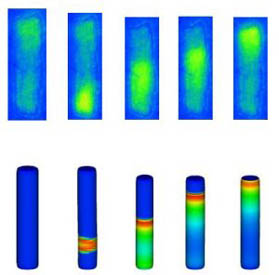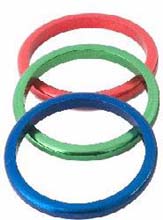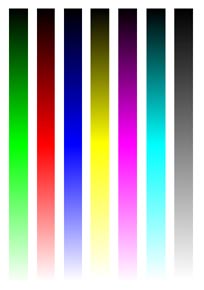The Colour of Wednesday
I thought I was normal until I had this argument with my sister. I was about nine, she’d be six. We were disagreeing, ferociously, about the colour of Wednesday.
‘Don’t be silly,’ Mum cut across us. ‘Wednesday doesn’t have a colour.’
‘Yes, it has!’ we rounded on her, instantly united.
 After that, we both kept quiet about it in case anyone thought we were mad. However, now that this subjective phenomenon of synaesthesia, when senses cross over, has been objectively validated, I can acknowledge it.
After that, we both kept quiet about it in case anyone thought we were mad. However, now that this subjective phenomenon of synaesthesia, when senses cross over, has been objectively validated, I can acknowledge it.
Not only Wednesday, but every letter and number has a colour. When I speak, write, listen, read or think, the words and figures are strung out in a single coloured line moving across the pale grey plain of my mind’s eye. The colours in each word flare slightly then fade as its significance passes.
There’s a logic to the way they work. For example, Wednesday is bottle green, taking its colour from the ‘w’ – the first letter always dominates and determines the colour of the word – although the ‘d’s (dark red) and the ‘n’ (light burgundy) add a darkness to the day. The remaining letters have little influence, being pale yellows and sandy shades; for my sister, Wednesday is blue.
With numbers, the colours help both with memory and with calculations. All my times-tables are patterns of colour which I see in my head before I distinguish the actual digits. The sweetness with which grass green 3 squares to pine green 9 is transcendent.
However, there is also room for confusion. Multiplying 11 x 11 and 11 x 12 is impossibly confusing because of the paleness of all the digits both before and after multiplying them. (1 is transparent and 2 is white). Fortunately 12 x 12 squares to a healthy dark red 144.
 Provided the colours are in my favour, my memory and spelling are near flawless. If someone is uncertain about whether a meeting’s on the 16th or the 17th, I can be sure: 16 is dark blue, 17 is pale blue. And it could never have been the 14th (dark red) or 13th (grass green). Monday and Tuesday are pale blue and dark red respectively, and well distinguished, but Tuesday and Thursday are easily confused, and only length separates Saturday from Sunday. However, if I cite my synaesthesia and state that it was definitely the 17th because it’s pale blue, people stare at me in blank incomprehension.
Provided the colours are in my favour, my memory and spelling are near flawless. If someone is uncertain about whether a meeting’s on the 16th or the 17th, I can be sure: 16 is dark blue, 17 is pale blue. And it could never have been the 14th (dark red) or 13th (grass green). Monday and Tuesday are pale blue and dark red respectively, and well distinguished, but Tuesday and Thursday are easily confused, and only length separates Saturday from Sunday. However, if I cite my synaesthesia and state that it was definitely the 17th because it’s pale blue, people stare at me in blank incomprehension.
There can also be a sense of discord when the meaning of the word clashes with its colour. For example, the colours of the words ‘blue’, ‘red’ and ‘yellow’ are all in harmony with their meaning. But ‘green’ is a blue-grey word, ‘orange’ is white and ‘white’ is green.
Apart from my sister, I don’t know anyone else who experiences this. The incidence is almost always in females, there is a demonstrable genetic connection and it occurs in about one in 10,000. Neither of our parents is synaesthetic – one’s a mathematician, the other a musician – although our mother used to dream in shorthand.
My sister remembers by coloured numbers, and has a phenomenally sharp sense of personal chronology, knowing  exactly which year any family event took place. I’m very vague on such things, but I remember words, names, places by colour. All the months of the year are sharply defined, apart from June and July. I have to make a particular effort to remember birthdays in these inseparably pale months.
exactly which year any family event took place. I’m very vague on such things, but I remember words, names, places by colour. All the months of the year are sharply defined, apart from June and July. I have to make a particular effort to remember birthdays in these inseparably pale months.
Neither of us feels confident about driving on the wrong side of the road, and synaesthesia is a major disadvantage when I play music. I think in sol-fa, which gives the melody line one set of colours, but each note also has a colour related to the key it is in, which inevitably conflicts with the sol-fa, and if the tune is then transposed into a different key, well
… my brain hurts!
We have the most common form of synaesthesia, which combines words and numbers with colours. Recent neurological research has shown that the part of the brain involved with colour perception is activated in synaesthetes who hear words with colours, but not in those who don’t – other, more exotic forms of sensual cross-over also exist where tastes, smells and sounds can have textures and shapes.
It’s easy for people to imagine, or impose colours or shapes on sensations, but for the synaesthete there is no choice. I could no more switch off or change my colours, than I could stop thinking.
I enjoy having these colours in my head. They are like friends, like aides-mémoire. They give letters and numbers an almost emotional character. My favourite colour is green – 3 and 9 and ‘w’. My Christian name is regrettably blue, but once when I worked at the Edinburgh Film Festival, a Turkish delegate insisted on mispronouncing my name label, calling me ‘Wol’. Part of me tried in vain to correct her, the other part blessed her.
My sister and I don’t argue any more. She has given me a copy of her colours and we respectfully agree to differ. But I envy her. Unlike me, she has a pink letter. If I could, I’d trade her any letter for that. Except ‘w’.
© Valerie Thornton 2005

Jayne on Wed, 8th Sep 2010 12:25 am
This is the most comprehensive description of synaesthesia I have read so far!
I can relate to what you’re saying as I have colourful weekdays and numbers, and some letters too. (I also see colours when experiencing very strong emotions).
Your visual synaesthesia seems much more marked and than mine; unlike you I don’t have reasons for why I see Wednesday as green, Tuesday as yellow and Thursday as a brownish-red colour, at least not any that I can figure out. I also don’t have colours for the numbers above single digits, and only certain letters ever show me their colours.
One thing I could particularly relate to was comparing colours of the week with your sister. My sister and I did this too. Our colours were different, and neither of us could understand how it was possible for them to be any colour other than our own! We didn’t realise that not everyone has colourful days, as we never thought to discuss it with anybody else. It’s only recently that I’ve discovered it’s not a “normal” thing.
Great article, and a lovely, refreshing read for me.